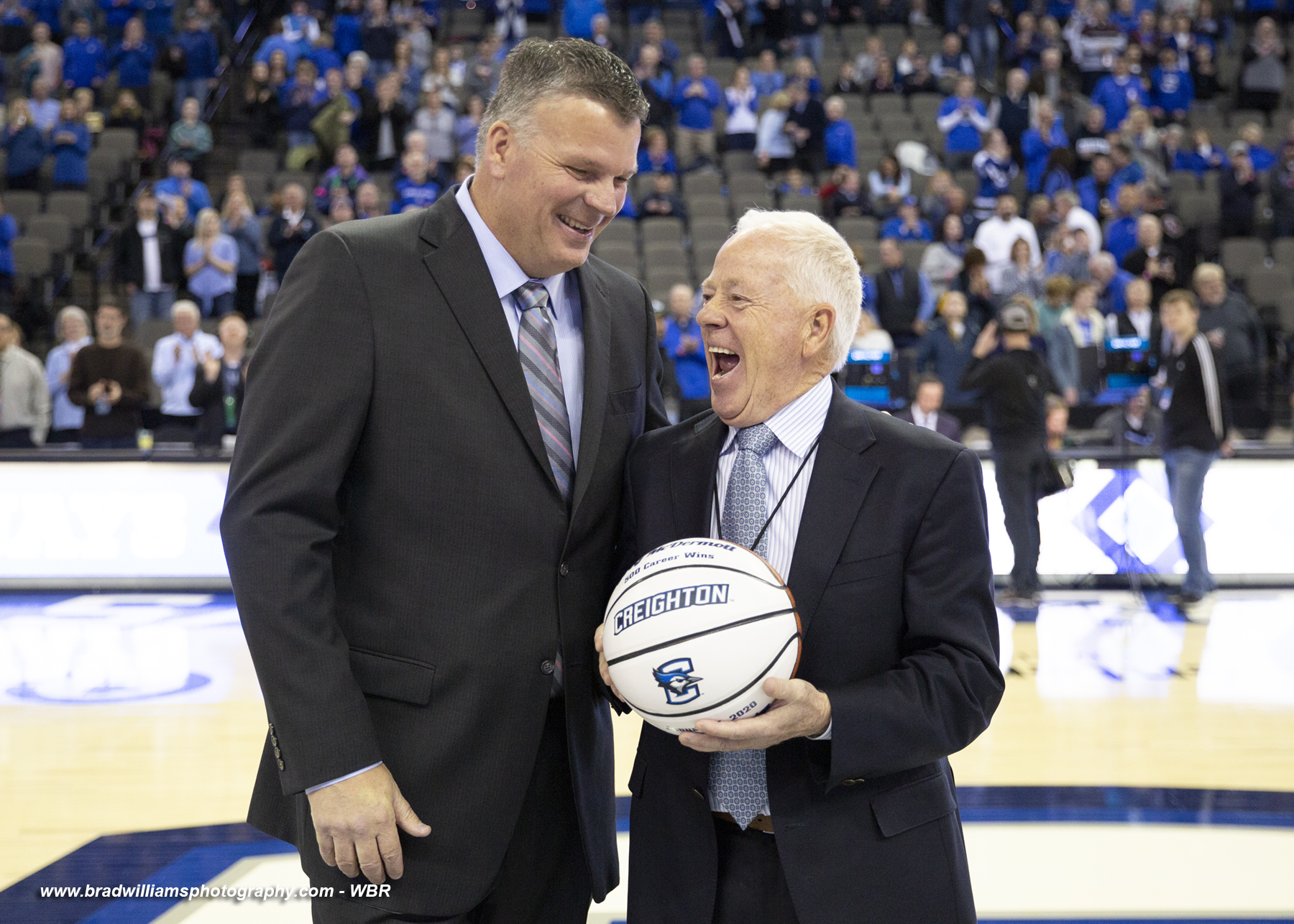In 1994, Bruce Rasmussen took over a Creighton athletic department with a $3 million annual budget and marquee sports that were in various signs of disarray, split across two leagues (the MVC and the WAC). He departs 27 years later having built the department into one that has been wildly successful on and off the field in the major conference spotlight of the Big East, bearing little resemblance to the one he inherited. To those of us who were there, the difference is incomprehensible, and the biggest reason for the growth spurt is the guy affectionately known as “Rass.”
On the personnel side, he was a brilliant judge of talent. He hired great coaches across the board, which is a hard enough feat for an A.D. to pull off. Then he managed to keep those coaches around, often in spite of interest from bigger names offering bigger paychecks. Of the department’s 12 head coaches, seven have been at Creighton for at least 19 seasons. All of them say the reason they stick around is because they know they’ll never work for a better boss anywhere else.
On the fundraising side, he raised money to build new facilities for nearly every major sport and brokered deals for other teams to play in new city-owned facilities. Morrison Stadium and CHI Health Center Omaha opened during the 2003-04 academic year, giving state-of-the-art homes to soccer and men’s basketball, respectively. The Wayne and Eileen Ryan Athletic Center and D.J. Sokol Arena opened in 2009 as home to women’s basketball and volleyball. TD Ameritrade Park Omaha, home to Bluejay baseball and the College World Series, opened in 2011. A year later Creighton opened a student recreation center and indoor practice facility for baseball and softball named the Rasmussen Center named in his honor. In 2014, the Championship Center opened as a practice facility for men’s basketball and athletic training, academic and athletic performance headquarters for all sports. And in the spring of 2019 the Ruth Scott Training Center opened as a practice facility for women’s basketball and volleyball.
It’s not a pristine legacy. The men’s basketball program is on two years probation as he departs, and Rasmussen’s actions in conducting a secret internal investigation were criticized by the infractions committee.
That doesn’t overshadow the mountain of accomplishments his department celebrated. In his time as athletics director, Creighton won 43 regular-season and 43 conference tournament titles, which have helped lead to 90 postseason appearances. Since joining the Big East, Creighton has won league titles at least once in every major sport — baseball, men’s basketball, men’s soccer, women’s basketball and volleyball. And Creighton has appeared in the postseason in 22 of the last 24 years in men’s basketball, 24 of the last 29 men’s soccer seasons and 10 of the last 11 NCAA Tournaments in women’s volleyball.
“I take great comfort in knowing that the program is in good hands with the amazing staff we currently have in our athletics department,” Rasmussen said in a statement. “I have always tried to do what is right for Creighton University. This is without doubt the most difficult professional decision that I have ever made. I have spent a great amount of time thinking about this. This is the right time for me. It is short notice because I am uncomfortable with farewell tours and long ‘good-byes’.”
You can’t truly replace someone as accomplished as Rasmussen. Whoever the next athletic director is, they’ll be tasked not only with running a major conference athletic program, they’ll also be taking over for a legendary, transformational figure. In many ways it can be a daunting, almost thankless task.
But when you go back and look at what Creighton Athletics was like in the summer of 1994, you realize that in other ways it’s also an easier job today than it was in those days.
***
Men’s basketball attendance had dropped over 50% from the 1990-91 NCAA Tournament team, with roughly 2,500 season ticket holders still hanging on after just 24 total wins in three years under Rick Johnson. The team played their games in a pre-renovation Civic Auditorium, at that point a mid-century facility that looked basically the same as it had during Red McManus’ heyday in the 1960s, for better and (mostly) worse.
Speaking of facilities, men’s and women’s soccer were successful, but played home matches at Tranquility Park, a city soccer complex a dozen miles from campus in northwest Omaha. By late fall of 1993 when the men’s team hosted the MVC Tournament and a first round NCAA Tournament match, that complex’s “stadium field” — the only one with permanent seating and lights — was closer to a parking lot than a grass playing surface because of how much it had been used by CU’s two teams and by local club teams. Early season matches in 1994 were played on auxiliary fields where fans needed to bring their own lawn chairs in an attempt to keep the stadium field in playable condition by NCAA Tournament time.
The volleyball program was relatively new and played at an array of local high school gyms. Women’s basketball split time between the Civic and the on-campus Kiewit Fitness Center and Vinardi Center. Baseball was just three years removed from a College World Series berth, but was reeling from a 1993 controversy where a jealous in-state rival fabricated a bunch of alleged NCAA violations, turned them into the NCAA, and forced them to use scant resources to defend themselves against allegations the NCAA ultimately decided were petty secondary violations not worthy of punishment. (This is a whole story unto itself, but in short: The “worst” violations were volunteer team physician Doc Bevilacqua letting a sick player sleep on his couch instead of his dorm room to rest up, and another player having his lunch tab covered by his head coach because he forgot his wallet in his room. The player immediately reimbursed him afterward.)
The school’s previous A.D., Dick Myers, had piloted a department with no cohesion or direction. There was little to no marketing budget, programs beyond men’s hoops more closely resembled intramurals than D1 teams, and the department ran so lean that there was no NCAA compliance officer on staff. They were ill prepared for the college sports explosion of the 1990s. For a myriad of reasons, dropping down to Division III was a serious option considered by the school.
Then-men’s soccer coach Bob Warming told the Omaha World-Herald in 1994, “Tom (Moore) came in when a lot of people were disenchanted with the path the department was taking. He did a great job of getting people together and getting them on the same page when times were tough.”
Moore was the transitionary figure, a successful businessman and passionate decades-long Jaybacker who shepherded the department into a more stable place. He also mentored a former coach-turned-administrator and involved him in every facet of running the department, from fundraising to promotions to marketing to fostering a culture of trust with the department’s coaches.
That administrator? Bruce Rasmussen.
When Rasmussen assumed the A.D. role in the summer of 1994, his number one task was to get men’s basketball winning again. He helped lure Kansas State coach Dana Altman to the hilltop a couple of months before taking over the A.D. role, and Altman eventually took the program to new heights — three regular season MVC titles, six MVC Tournament titles, and 13 consecutive seasons of postseason play including seven NCAA Tournament berths. Along the way, they moved first into a refurbished Civic Auditorium and later into the brand-new Qwest Center Omaha, a leap of faith that the program could fill an NBA-sized arena on a nightly basis less than a decade removed from crowds of less than 2,000 at many games. By Altman’s last year in Omaha in 2009-10, the Jays drew 302,676 fans to home games, ranking 12th nationally in attendance.
Faced with finding a replacement for the legendary Altman, Rasmussen lured another Big Eight/Big XII coach away. This time it was Greg McDermott, and he’s managed to do the improbable — not only matching but exceeding the expectations that Altman had set for the program. In 11 seasons, he’s taken them to six NCAA Tournaments and advanced to the program’s first Sweet 16 since 1973-74.
The soccer programs moved into the $13 million Morrison Stadium in 2003, going from a city park to arguably the finest on-campus soccer stadium in the country. Bluejay men’s soccer won 12 regular season conference titles, 11 conference tournament titles, and earned 22 NCAA Tournament berths during Rasmussen’s tenure as A.D. They also made 11 Elite Eight appearances and five College Cup appearances. Their sustained run of success is in no small part attributable to Rasmussen’s ability to hire the right coach time after time — from Bob Warming to Bret Simon to Jamie Clark to Elmar Bolowich to Johnny Torres.
That knack for making the right hire showed up in women’s hoops, too, where he followed up the great Connie Yori with Jim Flanery, the program’s all-time leader in wins. He’s guided them to four NCAA Tournament berths and 10 WNIT’s, and won three regular season titles in 19 years as head coach. It showed up in baseball, where Rasmussen hired Ed Servais, a coach whose emphasis on fundamentals and strong defense has built a consistent winner in a sport where northern schools — especially private schools — have generally enjoyed only sporadic success. His teams have five NCAA Tournament appearances in 17 seasons, and he’s sent numerous players to the major leagues.
But nowhere has it been on better display than in volleyball, where he hired a virtual unknown in Kirsten Bernthal Booth and gave her the resources to build a powerhouse. Since inheriting a 3-23 team in 2002, Booth has steadily built a program that has appeared in the AVCA’s Top 25 poll each of the last nine years, and reached 10 of the last 11 NCAA Tournaments. That includes a 2016 run to the Elite Eight, Sweet Sixteen trips in 2015 and 2016 and an unprecedented six straight outright Big East regular-season titles.
It’s an almost incomparable legacy, which is why so many players, coaches, and fellow administrators took to social media to share their thoughts after his announcement. Here’s some of them:


